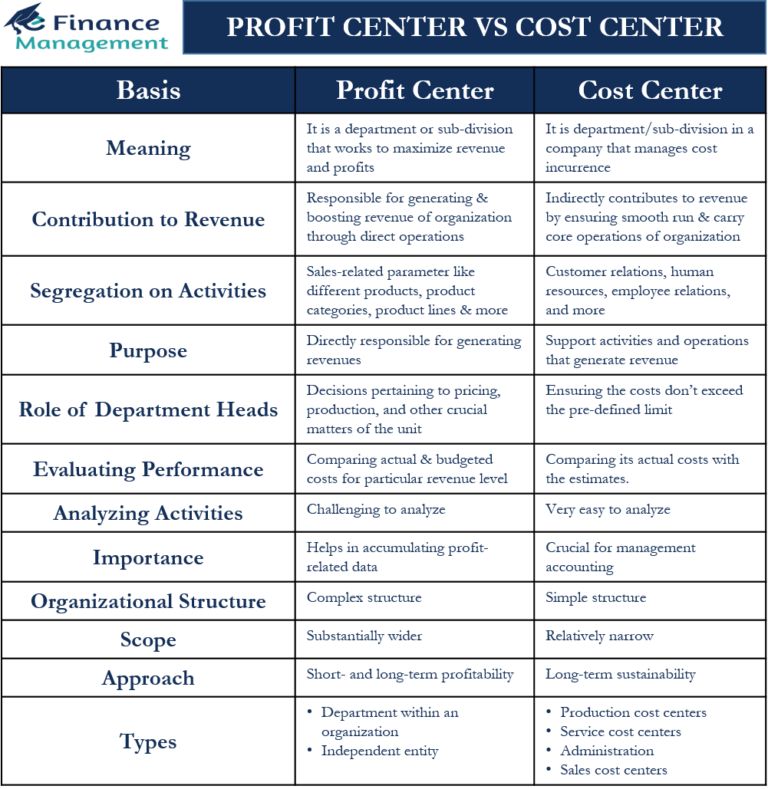
Set revenue targets for profit centers to ensure they align with the organization’s overall financial goals. Regularly monitor the performance of cost centers to ensure that they meet their goals and targets. It can be done by using key performance indicators (KPIs) relevant to the specific functions of the cost center.
Notable Differences – The Key Differences Between Cost Centers and Profit Centers
They are often managed as separate entities within the organization, with their own profit and loss (P&L) statements. Organizations can gain insights into their overall performance by tracking performance metrics for cost and profit centers. It can help identify areas for improvement and ensure that the organization is moving toward its overall goals. Moreover, cost centers are accountable for controlling and avoiding unnecessary expenditures, as their primary objective is to support the rest of the organization cost-effectively. The key performance indicators (KPIs) for cost and profit centers differ significantly based on their primary objectives.
Key Takeaways:
A profit center is a subunit of a company that is responsible for revenues and costs. If a division of a company has responsibility for revenues, costs, and the resulting profits, it is a profit center. The industry in which the organization operates can also influence the decision. For example, a cost center may be more appropriate in industries where cost control is critical, such as manufacturing. A profit center may be better in sectors where revenue generation is vital, such as retail. Analyze profitability regularly to ensure that the profit center generates sufficient revenue to cover costs and contribute to the organization’s bottom line.
Smarter Decision-Making
To optimize profits, management may decide to allocate more resources to highly profitable areas while reducing allocations to less profitable or loss-inducing units. At the retailer Walmart, different departments selling different products could be divided into profit centers for analysis. For example, clothing could be considered one profit center while home goods could be a second profit center. When the 6 best small business accounting software 2023 choosing between a cost center and a profit center, organizations should consider the center’s purpose, accountability, revenue potential, costs, industry, and organizational structure. Encourage innovation in profit centers to help them identify new revenue streams and expand their product or service offerings. It can be achieved through brainstorming sessions, ideation workshops, and other strategies.
- The performance of cost centers is typically evaluated based on their ability to manage expenses effectively and efficiently while meeting the organization’s needs.
- While both are essential for evaluating the performance of different business units, they have distinct attributes and serve different purposes.
- Therefore, external financial statements are generally prepared with line items displayed as an aggregate of all cost centers.
This can make it challenging for managers to evaluate the true performance and contribution of different parts of the organization, as spend doesn’t simply tell the entire story. A cost center is a unit of a business that isresponsible for incurring of costs. A cost center is generally that part of abusiness that does not directly generate revenue but supports the functioningof key revenue generating departments of a business. A cost center is termed as such as costs are incurred byit to keep it running. While these terms may sound familiar, it is essential to understand their key differences and how they impact the overall financial performance of a company.
Is Sales a Cost Center? – FAQs
It allows profit centers to focus on maximizing revenue and profits while balancing the need to control costs and maintain operational efficiency. They provide insights into the financial performance of specific business units, enabling management to identify profitable areas and allocate resources accordingly. By analyzing profit center data, organizations can make informed decisions regarding product pricing, marketing strategies, and investment opportunities.
The principal object of a profit centre is to generate and maximise the profit by minimising the cost incurred and increasing sales. In multinational companies, the cost centre is authorised to decrease and manage the cost. These costs are generally monitored by analysing and deducting the actual cost incurred with the standard cost. Transfer price is nothing but the value placed on the exchange of goods and services between two profit centres. And the way in which we determine this profit, will decide the profitability of the supplying (selling) and receiving (buying) profit centre.

In cost centers, the primary goal of management is to control costs and ensure that the center operates efficiently. They are responsible for ensuring that resources are utilized effectively, and the prices are within the allocated budget. However, cost centers typically do not have the authority to make strategic decisions that directly impact the overall direction of the company or its revenue generation activities. Cost centers are typically evaluated based on their ability to manage costs effectively and efficiently. It is done through cost accounting, which involves tracking, analyzing, and allocating costs to different business units within the organization.
Profit centers are evaluated based on their ability to generate revenue and profits for the company. Key performance indicators (KPIs) like revenue growth, gross margin, and net income typically serve as a gauge of their success. A profit center is a business unit within an organization responsible for generating revenue and profits. Unlike cost centers, profit centers directly contribute to the company’s bottom line by selling goods or services to customers and generating revenue from those sales. Both cost centers and profit centers are essentialto the functioning of a business. The efficient operation of a business is aresult of the combined working of several departments of a business.
It is acknowledged upfront that a cost center will be unprofitable; however, a manager can still be held accountable to the degree at which they operate at a loss. On the other hand, an impersonal/machinery cost center isolates the costs of all non-employee costs. A company may be interested in only viewing the upfront cost, maintenance expenses, repair requirements, and other costs related to just the heavy machinery for a process. This type of cost center may coincide with other types of cost centers, as companies may want to know the non-personnel cost of a specific department, for example. Example – in a manufacturing concern, the productionand sales department of different product lines are profit centers.
In addition, be mindful that a locational cost center must also exclude revenue even if revenue is generated in the region. The sales of that region would simply be reported in a different profit center. External users of financial statements, including regulators, taxation authorities, investors, and creditors, have little use for cost center data. Therefore, external financial statements are generally prepared with line items displayed as an aggregate of all cost centers.
